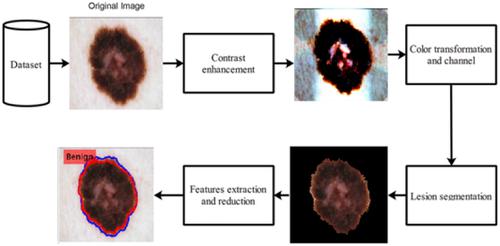当前位置:
X-MOL 学术
›
Microsc. Res. Tech.
›
论文详情
Our official English website, www.x-mol.net, welcomes your
feedback! (Note: you will need to create a separate account there.)
Microscopic melanoma detection and classification: A framework of pixel‐based fusion and multilevel features reduction
Microscopy Research and Technique ( IF 2.0 ) Pub Date : 2020-01-03 , DOI: 10.1002/jemt.23429 Amjad Rehman 1 , Muhammad A Khan 2 , Zahid Mehmood 3 , Tanzila Saba 1 , Muhammad Sardaraz 4 , Muhammad Rashid 5
Microscopy Research and Technique ( IF 2.0 ) Pub Date : 2020-01-03 , DOI: 10.1002/jemt.23429 Amjad Rehman 1 , Muhammad A Khan 2 , Zahid Mehmood 3 , Tanzila Saba 1 , Muhammad Sardaraz 4 , Muhammad Rashid 5
Affiliation

|
The numbers of diagnosed patients by melanoma are drastic and contribute more deaths annually among young peoples. An approximately 192,310 new cases of skin cancer are diagnosed in 2019, which shows the importance of automated systems for the diagnosis process. Accordingly, this article presents an automated method for skin lesions detection and recognition using pixel‐based seed segmented images fusion and multilevel features reduction. The proposed method involves four key steps: (a) mean‐based function is implemented and fed input to top‐hat and bottom‐hat filters which later fused for contrast stretching, (b) seed region growing and graph‐cut method‐based lesion segmentation and fused both segmented lesions through pixel‐based fusion, (c) multilevel features such as histogram oriented gradient (HOG), speeded up robust features (SURF), and color are extracted and simple concatenation is performed, and (d) finally variance precise entropy‐based features reduction and classification through SVM via cubic kernel function. Two different experiments are performed for the evaluation of this method. The segmentation performance is evaluated on PH2, ISBI2016, and ISIC2017 with an accuracy of 95.86, 94.79, and 94.92%, respectively. The classification performance is evaluated on PH2 and ISBI2016 dataset with an accuracy of 98.20 and 95.42%, respectively. The results of the proposed automated systems are outstanding as compared to the current techniques reported in state of art, which demonstrate the validity of the proposed method.
中文翻译:

显微镜下的黑色素瘤检测和分类:基于像素的融合和多级特征缩减的框架
黑色素瘤确诊的患者人数惊人,每年在年轻人中造成更多的死亡。2019年诊断出约192,310例新的皮肤癌病例,这表明自动化系统对于诊断过程的重要性。因此,本文提出了一种基于像素的种子分割图像融合和多级特征减少的皮肤损伤检测和识别的自动化方法。所提出的方法包括四个关键步骤:(a)实现基于均值的函数,并将输入输入到高帽和低帽滤波器中,然后融合以进行对比度拉伸;(b)种子区域增长和基于图割方法的病变通过基于像素的融合对两个分割的病变进行分割和融合,(c)直方图定向梯度(HOG)等多级特征,加快了鲁棒特征(SURF),提取颜色和颜色并执行简单的串联,然后(d)最后通过立方核函数通过SVM通过方差精确熵进行特征约简和分类。为了评估该方法,进行了两个不同的实验。在PH2,ISBI2016和ISIC2017上评估了细分效果,其准确度分别为95.86%,94.79%和94.92%。在PH2和ISBI2016数据集上评估分类性能,准确度分别为98.20和95.42%。与现有技术中报道的当前技术相比,所提出的自动化系统的结果非常出色,这证明了所提出方法的有效性。(d)最后通过立方核函数通过SVM进行方差精确的基于熵的特征归约和分类。为了评估该方法,进行了两个不同的实验。在PH2,ISBI2016和ISIC2017上评估了细分效果,其准确度分别为95.86%,94.79%和94.92%。在PH2和ISBI2016数据集上评估分类性能,准确度分别为98.20和95.42%。与现有技术中报道的当前技术相比,所提出的自动化系统的结果非常出色,这证明了所提出方法的有效性。(d)最后通过立方核函数通过SVM进行方差精确的基于熵的特征归约和分类。为了评估该方法,进行了两个不同的实验。在PH2,ISBI2016和ISIC2017上评估了细分效果,其准确度分别为95.86%,94.79%和94.92%。在PH2和ISBI2016数据集上评估分类性能,准确度分别为98.20和95.42%。与现有技术中报道的当前技术相比,所提出的自动化系统的结果非常出色,这证明了所提出方法的有效性。分别。在PH2和ISBI2016数据集上评估分类性能,准确度分别为98.20和95.42%。与现有技术中报道的当前技术相比,所提出的自动化系统的结果非常出色,这证明了所提出方法的有效性。分别。在PH2和ISBI2016数据集上评估分类性能,准确度分别为98.20和95.42%。与现有技术中报道的当前技术相比,所提出的自动化系统的结果非常出色,这证明了所提出方法的有效性。
更新日期:2020-01-03
中文翻译:

显微镜下的黑色素瘤检测和分类:基于像素的融合和多级特征缩减的框架
黑色素瘤确诊的患者人数惊人,每年在年轻人中造成更多的死亡。2019年诊断出约192,310例新的皮肤癌病例,这表明自动化系统对于诊断过程的重要性。因此,本文提出了一种基于像素的种子分割图像融合和多级特征减少的皮肤损伤检测和识别的自动化方法。所提出的方法包括四个关键步骤:(a)实现基于均值的函数,并将输入输入到高帽和低帽滤波器中,然后融合以进行对比度拉伸;(b)种子区域增长和基于图割方法的病变通过基于像素的融合对两个分割的病变进行分割和融合,(c)直方图定向梯度(HOG)等多级特征,加快了鲁棒特征(SURF),提取颜色和颜色并执行简单的串联,然后(d)最后通过立方核函数通过SVM通过方差精确熵进行特征约简和分类。为了评估该方法,进行了两个不同的实验。在PH2,ISBI2016和ISIC2017上评估了细分效果,其准确度分别为95.86%,94.79%和94.92%。在PH2和ISBI2016数据集上评估分类性能,准确度分别为98.20和95.42%。与现有技术中报道的当前技术相比,所提出的自动化系统的结果非常出色,这证明了所提出方法的有效性。(d)最后通过立方核函数通过SVM进行方差精确的基于熵的特征归约和分类。为了评估该方法,进行了两个不同的实验。在PH2,ISBI2016和ISIC2017上评估了细分效果,其准确度分别为95.86%,94.79%和94.92%。在PH2和ISBI2016数据集上评估分类性能,准确度分别为98.20和95.42%。与现有技术中报道的当前技术相比,所提出的自动化系统的结果非常出色,这证明了所提出方法的有效性。(d)最后通过立方核函数通过SVM进行方差精确的基于熵的特征归约和分类。为了评估该方法,进行了两个不同的实验。在PH2,ISBI2016和ISIC2017上评估了细分效果,其准确度分别为95.86%,94.79%和94.92%。在PH2和ISBI2016数据集上评估分类性能,准确度分别为98.20和95.42%。与现有技术中报道的当前技术相比,所提出的自动化系统的结果非常出色,这证明了所提出方法的有效性。分别。在PH2和ISBI2016数据集上评估分类性能,准确度分别为98.20和95.42%。与现有技术中报道的当前技术相比,所提出的自动化系统的结果非常出色,这证明了所提出方法的有效性。分别。在PH2和ISBI2016数据集上评估分类性能,准确度分别为98.20和95.42%。与现有技术中报道的当前技术相比,所提出的自动化系统的结果非常出色,这证明了所提出方法的有效性。











































 京公网安备 11010802027423号
京公网安备 11010802027423号